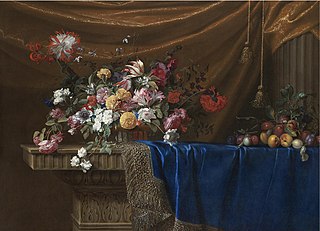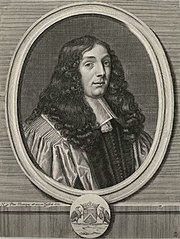Biography
His father was the Flemish painter and engraver Matthieu van Plattenberg, originally from Antwerp, who specialized in maritime scenes. In addition, his uncle was the engraver, Jean Morin, who gave him his first lessons in that subject.
In his youth, after learning the basics from his father, he studied with Philippe de Champaigne, one of the greatest painters and engravers in the Classical style. He also became a collaborator in the workshop belonging to Champaigne's nephew, Jean-Baptiste, who also became his lifelong friend. For many years, some of Plattemontagne's early works were confused with those by both of the Champaignes, and it is only rather recently that the confusion has been resolved.
From 1865 to 1656, under the direction of the elder, Champaigne, he participated in decorating the apartments of Anne of Austria at the abbey of Val-de-Grâce.
In 1663, he was accepted as a history painter at the Académie royale de peinture et de sculpture, and was later named a Professor. Previously, he had focused on portraits. Three years later, he was chosen to create the annual painting for the "Mays", commissioned by the Goldsmiths' Guild of Paris for Notre Dame Cathedral. He produced a "Saint Paul and Silas", which is now at the Louvre. In 1669, he was hired to decorate the apartments of Louis, the Dauphin at the Palais des Tuileries.
In 1703, Jean Ranc painted his portrait at the Château de Versailles. That painting served as Ranc's reception piece for acceptance at the Académie.
He was largely forgotten within a few years of his death. After some research around the turn of the 20th century, resulting in several reattributions, his corpus appears to comprise seventeen paintings and about eighty engravings or drawings.

Philippe de Champaigne was a Brabançon-born French Baroque era painter, a major exponent of the French school. He was a founding member of the Académie royale de peinture et de sculpture in Paris, the premier art institution in the Kingdom of France in the eighteenth century.

Gérard Edelinck was a copper-plate engraver and print publisher of Flemish origin, who worked in Paris from 1666 and became a naturalized French citizen in 1675.

Robert Nanteuil was a French portrait artist: engraver, draughtsman and pastellist to the court of Louis XIV.

Carle or Charles-André van Loo was a French painter, son of the painter Louis-Abraham van Loo, a younger brother of Jean-Baptiste van Loo and grandson of Jacob van Loo. He was the most famous member of a successful dynasty of painters of Dutch origin. His oeuvre includes every category: religion, history painting, mythology, portraiture, allegory, and genre scenes.

Adam Frans van der Meulen or Adam-François van der Meulen was a Flemish painter and draughtsman who was particularly known for his scenes of military campaigns and conquests. Van der Meulen also painted portraits, hunting scenes, paintings of chateaux and landscapes. He created designs for prints and cartoons for tapestries.

Jean-Baptiste Oudry was a French Rococo painter, engraver, and tapestry designer. He is particularly well known for his naturalistic pictures of animals and his hunt pieces depicting game. His son, Jacques-Charles Oudry, was also a painter.

Events from the year 1674 in art.
Ignace Brice was a neoclassical painter of genre, portraits and religious scenes from Brussels.

Louis Pierre Henriquel-Dupont was a French engraver. His students included Charles Bellay, Jean-Baptiste Danguin, Adrien Didier, Alphonse and Jules François, Adolphe-Joseph Huot, Achille and Jules Jaquet, Jules Gabriel Levasseur, Aristide Louis, Louis Marckl, Isidore-Joseph Rousseaux, Abel Mignon and Charles Albert Waltner.

Jean Ranc was a French painter, mainly active in portraiture. He trained under his father Antoine Ranc and his father's former student Hyacinthe Rigaud and served in the courts of both Louis XV of France and Philip V of Spain.

Louis-René Vialy, also spelled Vially, Viali or Viallis, was a French painter.

Jacques Fouquier, Jacques Fouquières or Jacob Focquier was a Flemish landscape painter. After training in Antwerp he worked in various places where he often obtained appointments as a painter to the court including that of the French kings. He earned great success and a very high reputation during his lifetime and was even referred to as the 'Flemish Titian'. Very few of his paintings have been preserved. His work was influential in his time and was widely circulated thanks to reproductions by various contemporary engravers.

Pieter van Mol or Peter van Mol was a Flemish painter known for his history paintings of religious subject matter, and to a lesser extent for his allegorical compositions, genre scenes and portraits. His style was profoundly influenced by Rubens, Abraham Janssens and Artus Wolffort. He was court painter to the King and Queen of France.
Jean-Charles Tardieu, also called "Tardieu-Cochin" was a successful French painter during the ages of Napoleon and of the Bourbon Restoration. His work was primarily historical, but also included landscapes, portraits and religious subjects.

Nicolas-Henri Tardieu, called the "Tardieu the elder", was a prominent French engraver, known for his sensitive reproductions of Antoine Watteau's paintings. He was appointed graveur du roi to King Louis XV of France. His second wife, Marie-Anne Horthemels, came from a family that included engravers and painters. She is known as an engraver in her own right. Nicolas-Henri and Marie-Anne Tardieu had many descendants who were noted artists, most of them engravers.

Jean Morin was a French baroque painter, printmaker, painter, etcher, engraver and publisher. He is mainly remembered as a printmaker, whose innovation in combining engraving with etching on the same plate became extremely common.

Matthieu or Matthijs van Plattenberg, known in France as Matthieu de Plattemontagne, Matthieu de Platte Montagne and Matthieu Montaigne was a Flemish Baroque painter, draughtsman, etcher and engraver who specialized in marine paintings and landscapes. He spent most of his career abroad, first in Italy and then in France where he played an important role in the development of the painting of stormy seascapes.

Jean Nocret was a French painter who is best known for his portraits of the French royal family. Many portraits of uncertain origin have been attributed to him.

Jean-Michel Picart or Jean-Michel Picard was a Flemish still life painter and art dealer active in France. After training in Antwerp, he moved to Paris where he had a brilliant career and became court painter to king Louis XIV. He is known for his flower and fruit still lifes. He was together with Jean-Baptiste Monnoyer one of the most successful still life painters in France in his time. As an art dealer he was a link between Antwerp dealers and the Paris market.






















